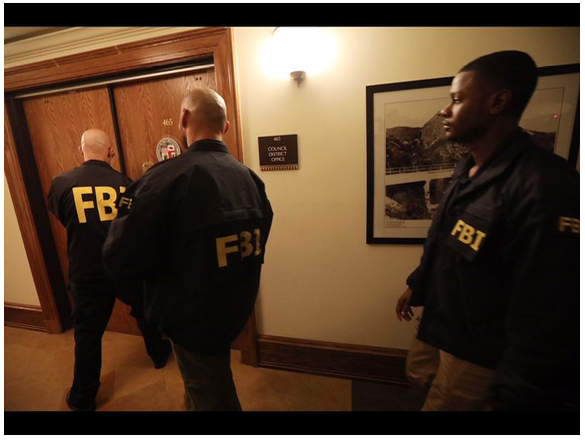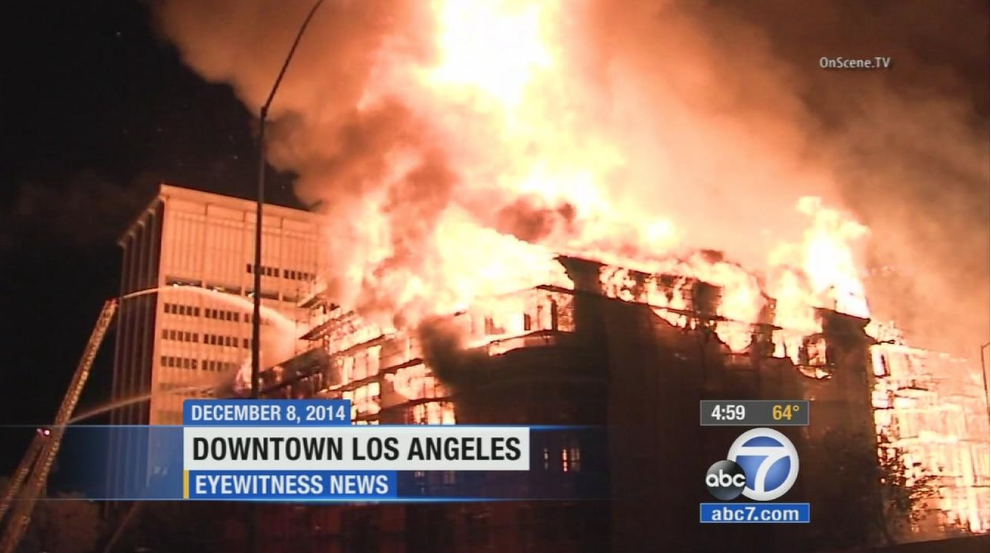CommentsPLATKIN ON PLANNING-The current FBI investigations of City Hall corruption are over due. Hopefully, the FBI will now reach past the low hanging fruit of sweetheart pay-to-play deals to uncover hard facts and produce indictments of higher levels of corruption.
If we jump back to 2016, when Measure S, the Neighborhood Integrity Initiative, threatened to shut-down pay-to-play at City Hall, City officials made lavish promises to put the kibosh on pay-to-play. But, the threat to replace planning-by-bribes with accelerated updates of the General Plan, including its Community Plans, lost. Business-as-usual quickly returned to City Hall, but it ushered in so much sleaze that it could no longer be hidden behind closed doors. Hence, the current FBI investigations:
- The FBI raided Councilmember Jose Huizar’s house and offices to investigate Federal charges of bribery, kickbacks, conspiracy, money laundering, racketeering, and conflicts of interest.
- Councilmember Curran Price has also been named in the FBI investigation.
- Jose Jacinto, a Garcetti appointee to the Board of Public Works, also resigned because of the FBI investigation.
- Herb Wesson’s Chief-of-Staff, Deron Williams, is also included in the Federal warrant.
- Raymond Chan, formerly the General Manager of the Department of Building and Safety and Mayor Garcetti’s Deputy Mayor is on the FBI list.
Where the FBI investigation and press coverage now needs to move is to higher levels of corruption. This is where the smoke is billowing, and the corruption driving it should not be hard to uncover. City Hall corruption is hardly limited to elected officials pushing through zoning and planning waivers for individual real estate projects, especially in Hollywood and Downtown Los Angeles. It also includes developers and lobbyists who promote special land use ordinances at the State (SB 827 and SB 50) and municipal levels.
These laws and local ordinances increase the market value of thousands of commercial parcels by expanding their permitted uses, densities, heights, and mass (FAR). They also exempt future real estate projects from the California Environmental Quality Act, and they can reduce or eliminate zoning requirements for setbacks and on-site parking. These gifts are quite literally worth billions.
In LA some of the planning gimmicks to channel these up-zoning gifts include:
- Re:code LA.
- Density bonuses through the City’s SB 1818 ordinance and TOC Guidelines.
- Community Plan Update land use implementation ordinances.
- North Westlake Design District.
- Transit Neighborhood Plans (TNP), especially for the Purple and Orange lines.
In the case of the Purple Line TNP, the smoke is filling the room and the evidence of corruption is becoming more visible. Furthermore, when we ask, “Who Benefits?” more evidence is sure to waft up, with or without the FBI impounding City Hall computers, files, and appointment calendars.

The Purple Line Transit Neighborhood Plan’s (TNP) signs of corruption:
If adopted, this proposal will become a Specific Plan that permanently increases the heights, densities, and size of buildings on the Wilshire, Fairfax, San Vicente, and LaBrea corridors and adjacent streets. Its cover stories do not remotely pass the smell test, and some of them are based on outright lies.
Lie # 1) The Purple Line transit neighborhood plan cannot be folded into the impending update of the Wilshire Community Plan because METRO would then require the City of Los Angeles to refund its $4.5 million dollar planning grant. There is no evidence to back up this claim, which is also contradicted by the proposed Orange Line Transit Neighborhood Plan, sections of which will be prepared through Community Plan Updates.
Lie # 2) It is standard practice to determine the environmental impacts of a Specific Plan before the Specific Plan exists. No, this is not standard practice. How is it even possible to figure out the environmental impacts of detailed planning and zoning laws before they are known? In this particular case the public still does not know the Purple Line Transit Neighborhood Plan’s basic features, such as its design review requirements, new parking standards, public improvements, yet-to-be-finalized re:code LA zones, overlay zones, and monitoring program.
Below this billowing smoke are glowing embers, all of which reek of the behind-the-scenes deals and meetings uncovered through corruption investigations:
Glowing Ember #1) No local community groups, including Neighborhood Councils, HPOZ boards, and Neighborhood, Homeowner, and Resident Associations were ever briefed or asked about the draft Neighborhood Transit Plan’s (TNP) up-zoning proposals. Nevertheless, developers and a real estate lobbying group, Abundant Housing Los Angeles, were in City Planning’s loop during the past two years, allowing City Planning to use their written comments to justify the TNP’s up-zoning schemes.
Glowing Ember # 2) No TNP background studies have been made public. METRO grants were supposed to fund them, but, if the studies METRO paid for exist, they have been kept under wraps. How much residential construction has taken place in recent years? What are rents, vacancy rates, and transportation behavior? Do new residents use transit? Do new apartment buildings subsidize transit? Why is transit ridership on nearly all local bus lines declining, despite large amounts of new apartment construction? How will property owners and businesses respond to up-zoning?
Glowing Ember # 3) Assertions that existing zoning impedes transit use and apartment house construction are baseless. The TNP area has vast amounts of underutilized zoning, despite the construction of many new residential and commercial buildings since the 2002 update of the Wilshire Community Plan.
Glowing Ember # 4) City Planning presents the Purple Line TNP as part of the Purple Line Extension, but METRO only posted several sentences about its two planning grants. You cannot find the TNP on any METRO Purple Line websites, and the public has never seen any City Planning progress reports for METRO or METRO’s response to these reports. As for Beverly Hills, it is not part of the Transit Neighborhood Plan, even though LA City Planning includes Beverly Hills’ Wilshire/LaCienega subway station in its TNP descriptions.
Glowing Ember # 5) METRO’s and City Planning’s own published guidelines on how to plan for transit corridors have been totally ignored. METRO’s First-Last Mile Strategic Plan, and City Planning’s Mobility Hubs and Complete Streets Design Guide are totally missing-in-action from the TNP.
Evidence of corruption in the Purple Line TNP’s public record
The public record is large, but most of the information that would reveal City Hall – private interest groups communications and decision-making processes -- that morphed a METRO-funded transit- oriented district into a fast-tracked up-zoning scheme -- is not yet public. The list of TNP records that still need to be divulged is long:
- Communications between City Planning and METRO regarding the Purple Line and the Transit Neighborhood Plan (TNP), including grant progress reports and METRO’s feedback.
- External and internal studies confirming that the TNP’s two upzoning schemes will meet its goals of “expanding mobility choice, improving transit access, fostering transit ridership, and reducing greenhouse has emissions,” as well as, “adopting transit-supportive land use regulations.”
- External and internal studies demonstrating that the TNP’s two upzoning proposals will result in, “shorter vehicle trips; more walking, biking, and transit trips: and multi-destinational trips,” and, “a vibrant mix of uses near station areas, increased access to a variety of mobility options, zoning incentives for public benefits, and improved publicly accessible open spaces.”
- Any studies or communications explaining why the TNP, which is scheduled to conclude in 2020, should not be part of the Wilshire Community Plan update, which begins a year later, in 2021.
- Any communications among Council Offices, City Planning, and private interests and lobbying groups (e.g., Miracle Mile Chamber of Commerce, Miracle Mile Democratic Club, Abundant Housing Los Angeles) regarding the Transit Neighborhood Plan’s up-zoning boundaries and schemes, some kept under wraps until a third, minimally publicized public meeting took place on July 26, 2018.
- Any communications regarding the future Specific Plan and its Draft Environmental Impact Report (DEIR), including its July 12, 2018, backdated Notice of Preparation, and all responses from the public on the DEIR’s alternatives and impact categories.
Despite this critical but missing information, we do know the following from the records that have so far been made public.
1) Even though City Planning only held three public meetings, it initiated small focus groups with institutional and business groups outside the TNP area, such as Cedars-Sinai on February 21, 2017 and Park LaBrea on Feb. 7, 2017.
2) The first TNP public meetings (June 29 and 30, 2016) revealed that local residents wanted a transit neighborhood plan that promoted neighborhood oriented commercial uses, open and green space, bicycle amenities, mobility alternatives, adequate parking, safe crosswalks and sidewalks, densification restricted to immediate station areas, affordable housing, social services, historic preservation, safety, cleanliness, pedestrian amenities, and wayfinding signs. These priorities were quickly forgotten, though, while….
3) The second TNP public meeting, in November 2017, was packed with people from other neighborhoods linked to the Abundant Housing lobbying group. Local residents active in Neighborhood Councils, resident and neighborhood associations, HPOZ Boards, and homeowner associations did not attend for a simple reason: they did not know about the meeting. The Abundant Housing comments, many simultaneously submitted afterward through email software, then became City Planning’s justification for a second up-zoning option. These were then followed up by a meeting at 4 PM on February 22, 2018, between Abundant Housing leader Mark Villianatos and Patricia Diefenderfer, the Senior City Planner in charge of the Purple Line Transit Neighborhood Plan.
4) None of the emails, notices, flyers, and PowerPoint presentations that City Planning prepared mentioned that the public’s 2016 priorities had been abandoned and the TNP had become two up-zoning schemes.
What next? When the FBI investigations of City Hall officials, lobbyists, and donors, supplemented by Public Records requests, unfold, this small chapter of the City Hall corruption story will become more visible. Stay tuned, especially to watch those City Hall denizens who stonewall investigations and records requests, especially if they continue to fast track major zoning gifts to commercial property owners – like the Purple Line TNP -- before the Department of Justice eventually lowers the boom.
(Dick Platkin is a former Los Angeles city planner who reports on local planning controversies for CityWatch. Please send your questions, comments, corrections, and article tips to [email protected]) Prepped for CityWatch by Linda Abrams.
















